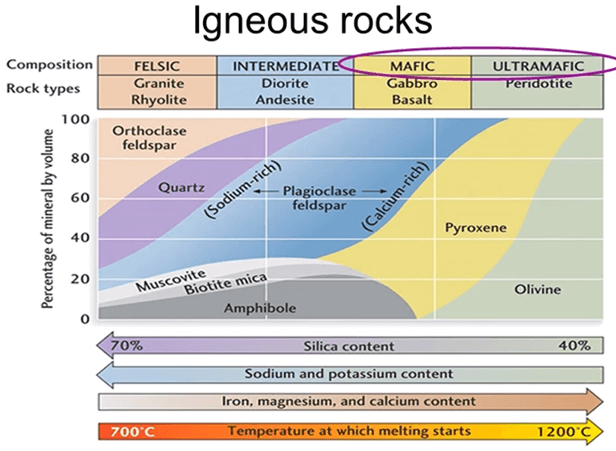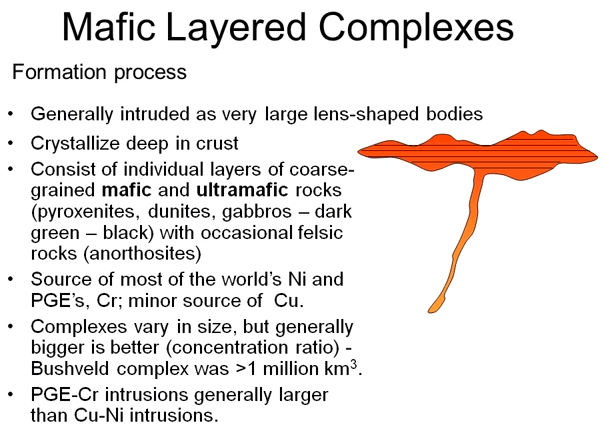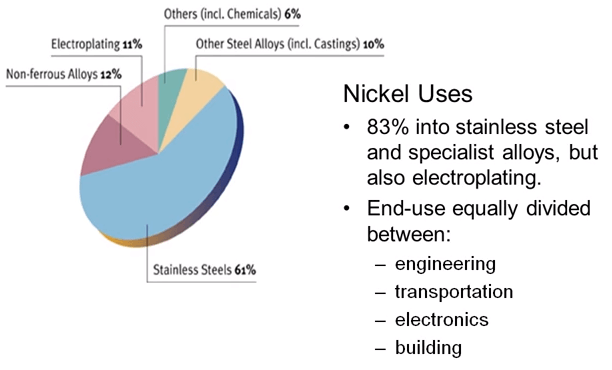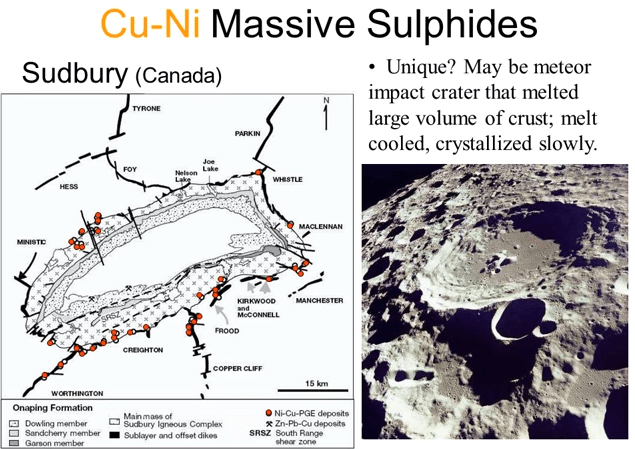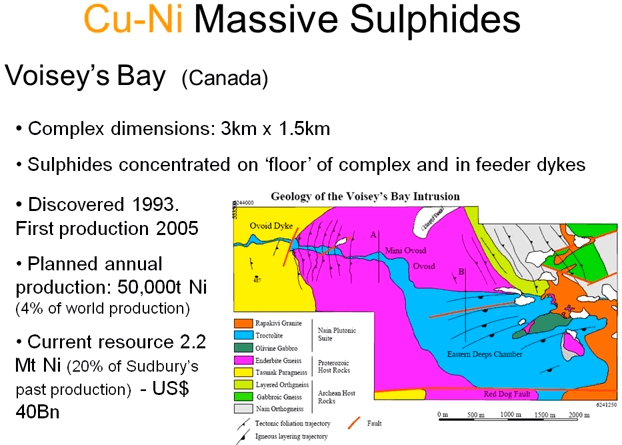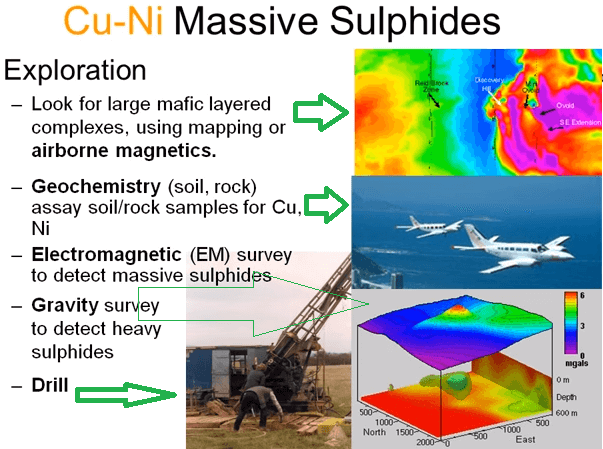Mafic Layered Intrusions and complexes including copper nickel massive sulfide, chrome and platinum group elements or PGE deposits. This course on massive sulphide deposits includes copper and nickel exploration methods, nickel sulphide inclusions exploring for copper and nickel sulphide minerals.
In the introductory Exploration Geology Course I mentioned felsic, mafic and ultramafic rocks but before I launch into talking about mafic layered complexes I should probably quickly review these descriptions for those who may not be exactly sure what they mean.
Igneous Rocks is where the majority of copper nickel massive sulfide and chrome platinum group metal deposits developed in large intrusions that are made up of layers of alternating mafic and ultramafic rock hence the name mafic layered complexes.
Now let’s launch into the main deposits types associated with mafic layered complexes which are the copper nickel massive sulfide, the platinum and chrome deposits.
Mafic layered complexes are generally very large pancake shaped intrusions that because of their high initial heat and deep burial tend to cool slowly. This allows them to develop the alternating layers of coarse-grained mafic and ultramafic rocks; pyroxenes, dunites and gabbros. As you might 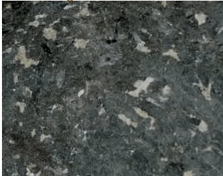 expect the rocks are generally black or dark green in color although they may also develop layers of feldspar that has high calcium content called anorthosite and anorthosite in contrast is almost white in color. The vast majority of the world’s nickel platinum group elements and chrome deposits are hosted in the mafic layered complexes and these metals tend to crystallize out of the magma impulses which allow them to be concentrated in discrete layers at potentially mineable grades. The layered complexes are generally very large they need to be to concentrate enough of the metals into an economic ore deposit.
expect the rocks are generally black or dark green in color although they may also develop layers of feldspar that has high calcium content called anorthosite and anorthosite in contrast is almost white in color. The vast majority of the world’s nickel platinum group elements and chrome deposits are hosted in the mafic layered complexes and these metals tend to crystallize out of the magma impulses which allow them to be concentrated in discrete layers at potentially mineable grades. The layered complexes are generally very large they need to be to concentrate enough of the metals into an economic ore deposit.
The monster of them all is the Bushveld complex in South Africa which is 400 km x 800 km and has a volume of at least 1,000,000 km³. Although some of the big layered complexes host copper nickel mineralization, most copper nickel massive sulfides deposits are in slightly smaller than intrusions which are less well layered. The Sudbury complex at 20 x 45 km is one of the biggest intrusions that hosts copper nickel deposits and it’s so well layered but Voisey’s Bay only 2.5 x 1.5 km in size and is a virtually non layered.
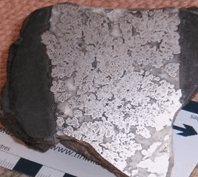 Now about these copper nickel massive sulfide deposits: Let’s clarify that when a geologist refers to massive sulfides he isn’t referring to size but to the fact that the sulfide crystals are in contact with one another rather than disseminated throughout the rock as isolated blebs; massive sulfide in the photo. Copper nickel massive sulfide deposits form by starting obviously with a magma that is rich in copper and nickel high copper nickel contents are not that unusual in mafic magmas in fact nickel is the fifth most common element in the earth as the magma intrudes the host rock it assimilates those host rocks and any sulfur that they may contain and this is usually in the form of pyrite which is fool’s gold or FeS2. If the hosts rocks don’t contain enough sulfur these ore deposits cannot form. So the presence of a sulfur rich host rock is actually more critical than having a copper nickel rich magma. The sulfur, nickel and copper combine in the magma to form an admissible copper nickel sulfide melt that is heavier than the rest of the magma and it collects and pools at the bottom of the magma chamber like water droplets in oil.
Now about these copper nickel massive sulfide deposits: Let’s clarify that when a geologist refers to massive sulfides he isn’t referring to size but to the fact that the sulfide crystals are in contact with one another rather than disseminated throughout the rock as isolated blebs; massive sulfide in the photo. Copper nickel massive sulfide deposits form by starting obviously with a magma that is rich in copper and nickel high copper nickel contents are not that unusual in mafic magmas in fact nickel is the fifth most common element in the earth as the magma intrudes the host rock it assimilates those host rocks and any sulfur that they may contain and this is usually in the form of pyrite which is fool’s gold or FeS2. If the hosts rocks don’t contain enough sulfur these ore deposits cannot form. So the presence of a sulfur rich host rock is actually more critical than having a copper nickel rich magma. The sulfur, nickel and copper combine in the magma to form an admissible copper nickel sulfide melt that is heavier than the rest of the magma and it collects and pools at the bottom of the magma chamber like water droplets in oil.
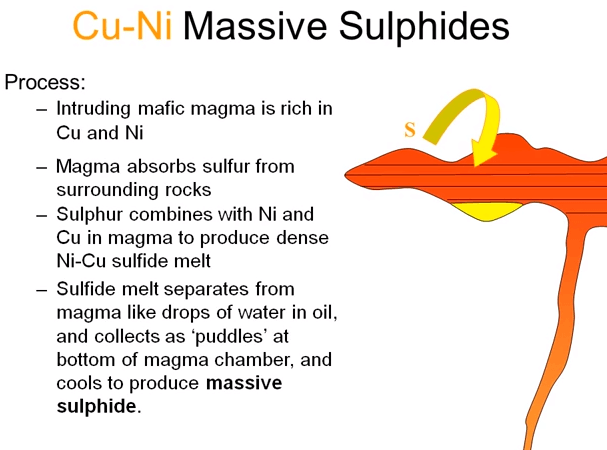 Platinum group metals are also sometimes concentrated in the submissible melt. As the magma chamber continues to cool both the sulfides and the remaining magma crystallize.
Platinum group metals are also sometimes concentrated in the submissible melt. As the magma chamber continues to cool both the sulfides and the remaining magma crystallize.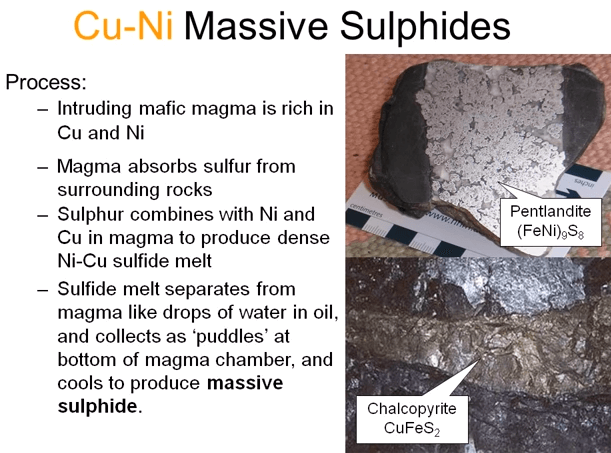
The main sulfide minerals are pentlandite which is nickel sulfide and chalcopyrite which is a copper ion sulfide.
Thirty six percent of global nickel production comes from sulfide deposits of this sort, the remaining 64% comes from nickel laterites which consist of weathered mafic rocks with much of the nickel coming from the crystal lattices of oxidized silicate minerals like olivine because you need warm and wet conditions for lateralization these usually form in Tropical areas and you can guess from their climates which of the producers in the pie chart rely on massive sulfides and which rely on laterites. 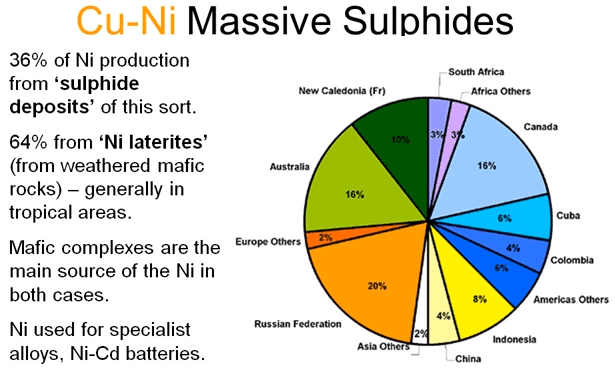 I fact the big three Canada, Russia, and Australia produce the majority of their nickel from copper nickel massive sulfide deposits but where there is sulfide or laterite cell, the main source of the nickel is mafic intrusives. The vast majority of the nickel that is produced goes into the manufacture of stainless steel and variety of specialist alloys. These allies are used by a wide spectrum industries and the amount that goes into Nikad batteries is relatively small. Nickel use is dominated by stainless steel and various specialist alloys which account for 83% of production. Stainless steel and alloys are in turn used by a wide range of secondary industries including engineering, transportation, electronics and building.
I fact the big three Canada, Russia, and Australia produce the majority of their nickel from copper nickel massive sulfide deposits but where there is sulfide or laterite cell, the main source of the nickel is mafic intrusives. The vast majority of the nickel that is produced goes into the manufacture of stainless steel and variety of specialist alloys. These allies are used by a wide spectrum industries and the amount that goes into Nikad batteries is relatively small. Nickel use is dominated by stainless steel and various specialist alloys which account for 83% of production. Stainless steel and alloys are in turn used by a wide range of secondary industries including engineering, transportation, electronics and building.
The main features of three of the most significant copper nickel massive sulfide hosting intrusions:
- Sudbury in Ontario
- Norilsk in Russia
- Voisey’s Bay in Labrador
1) This slide shows the geology of the Sudbury intrusive in Northern Ontario it may be unique in that it is thought to be the results of a massive meteorite impact that melted a large volume of the crust. This melted rock subsequently cooled and crystallized as a true layered complex. It’s being suggested that the nickel and the complex may have come from the meteorite itself but really isn’t necessary to call on this source as the typical crust will contain enough nickel to account for the mineralization if it was sufficiently concentrated. There is also controversy over the meteorite impact theory with opponents pointing out that its developed on a pre-existing major crustal suture which they consider to be an unlikely coincidence and they also point out that all impact craters even from glancing hits are circular not kidney shaped like Sudbury.
The hypothesis however the meteorite impact supporters provide evidence that later deformation may have flattened the Sudbury complex, the intrusion is after all 2 billion years old and there is also small structures called shatter cones which are indicative of sudden impact shock. At present the meteorite supporters seem to have the upper hand in this argument. The average composition of the entire intrusion is granodiorite i.e. felsic to intermediates but the layers that host the copper nickel mineralization are mafic as you would expect also as you would expect the massive sulfides are developed on the floor of the ball shaped complex. So the mines which are the little red dots on the plan rim the complex. It has been active in large scale mining at Sudbury’s since 1886 and is still ongoing at the moment Sudbury produces about 10% of the world’s nickel supply and to date has produced $320 billion worth of nickel.
2) Norilsk’s Cu-Ni Deposit is situated in Northern Russia just 200 miles from the Arctic Ocean. Geological this is a somewhat different beast from Sudbury. The mineralization hosted by six separate intrusions that form feeders to the Siberian traps. The Siberian traps resulted from a huge outpouring of basaltic lavas about 250 million years ago that covered 3.9,000,000 km² of Russia, The eruption has been blamed for triggering a series of events that led to the extinction of 95% of the earth’s species at the end of Permian period. Once again the copper nickel massive sulfides are concentrated in low points at the base of the intrusions. This is a section of drill core from Norilsk, the yellow material is chalcopyrite and the bronze colored material is pentlandite a nickel sulfide. As at Sudbury the Norilsk deposits also contain PGE’s. Norilsk consist of five underground mines which feed essential (Inaudible 13:44) these mines have been active since the second world war when they played a vital part in Russia’s was effort. It’s difficult to get up to date production figures but throughout 2005 Norilsk produced 243,000 tons of nickel or 15% of the world’s supply half as much again as Sudbury.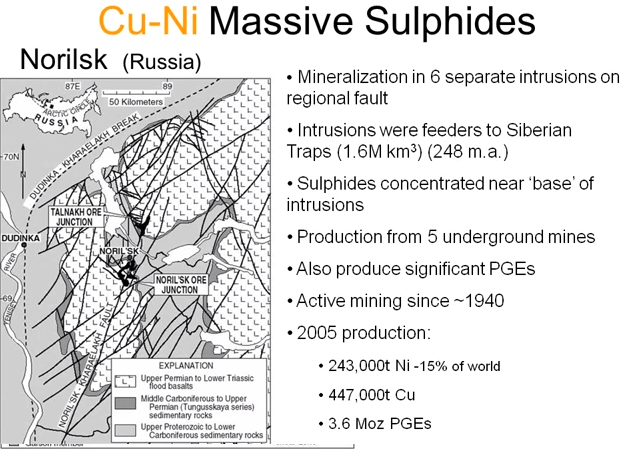
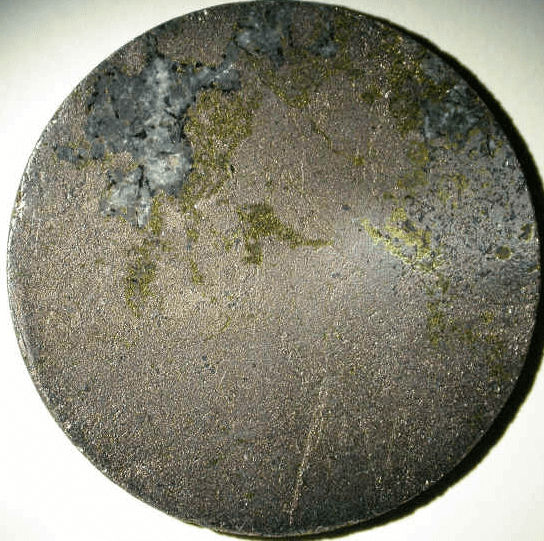
3) A last example of copper nickel massive sulfide that I’m going to talk about is Voisey’s Bay in Labrador. This intrusion which is the blue unit on the map, tadpole shaped and 3 km x 1 km in size but again the massive copper nickel sulfides have puddled on the floor of the magma chamber. The deposit was discovered in 1993 by two prospectors who were working for an exploration junior called Diamond Fields Resources. They were sampling for diamond indicator minerals and they came across a gossans, a gossans is an outcrop of oxidized massive sulfides. Follow-up drilling in 1994 gave an intersection of 41 m of nearly 3% nickel and 2% copper and a second ore body was discovered nearby the following year. The deposit was acquired by in Inco in 1996 and production began in 2005 slightly ahead of schedule. At present the concentrate is shipped from Voisey’s Bay to the smelter in Sudbury but a new smelt is being constructed on site and is due to begin production in 2011. Nickel production at Voisey’s Bay is expected to ramp up to 50,000 tons of nickel per year or 4% or world production. Current resources there are 2.2 million tons of nickel worth about $40 billion at today’s nickel price.
How to explore for copper nickel massive sulfide deposits:
We know that they are invariably hosted by large mafic intrusive and that these are often big enough to have developed layering. Most of these mafic intrusive bodies have significant magnetite content and so can be detected by geophysics even if they aren’t readily defined by out crop mapping. An airborne magnetic survey is the easiest way to map the limits over the intrusive if they don’t out crop. The magenta red and orange area in the top right figure is an example of how these intrusives typically appear on a magnetic survey. You can see the sting is in the tails of the aircraft where the magnetometer is housed during the survey. This avoids magnetic interference caused by the aircraft itself. Once you’re in the area i.e. the mafic intrusive itself you can detect the massive sulfides in one of three ways; by using soil or rock geochemistry and assaying directly for copper and nickel, using electromagnetics or EM as it is commonly known and that’s using a large electric lube to induce the magnetic field in the conductive material which massive sulfides are and this induced magnetic field is then detected, so it’s a two stage process.
This can give some idea of where the conductor is, how deep it is and how big it is but it cannot to tell whether that conductor was caused by copper and nickel sulfides or by some other conductor such as value less pyrite or graphite. You can use gravity surveys to look for anomalously dense rocks such as massive sulfides. The figure in the bottom right shows Voisey’s Bay the deposit as a green high density solid below the surface magnetic anomaly. The magnetic one is the red tipped one at the surface but again gravity cannot determine whether the anomaly is caused by copper and nickel sulfides or something of minimal value. To test this you need to drill. The drill is always the ultimate exploration tool but because it is expensive cheaper to your geophysical or geochemical exploration methods are generally used first to optimize the siting of the drill holes.
Copper nickel sulfide massive sulfides deposits are usually associated with large mafic intrusives many of these are layered. The general rule is the bigger the intrusion the better you need the large intrusions to provide enough metal content to be concentrated into a worthwhile deposit. Copper nickel massive sulfide accumulate as puddles on the floor of the intrusion. Exploration for copper nickel massive sulfides relies mainly on mapping and airborne magnetic surveys to identify the host intrusions and electromagnetics or EM and gravity to target drills.

